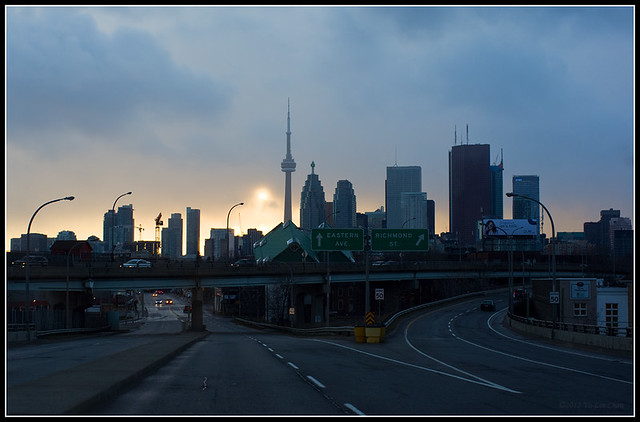Downtown Toronto in the evening -- NEX-5N & Olympus OM 35mm f2
Couple days ago I was driving towards downtown Toronto on Eastern Avenue, and I commented to my wife on how beautiful and interesting the sun was behind the buildings. I stopped the car (no car was coming behind me) and took a couple of shots. The picture above is one of the two, but it is not even close to the actual scene. It was far more brilliant and colourful. The sensor in the Sony NEX-5N is pretty good, but despite turning on the D-Range, the bright and dark range was still not captured large enough. I think current technology is already there to increase the dynamic range and colour depth, but manufacturers are not willing to give it to us, at least not as much as we want. The Canon 1DX sensor should be an indication of the trend that sensor makers are starting to make dynamic range and colour depth as new features, rather than high pixel count, which is encouraging. I am sure in a few years time, sensors in digital cameras will be able to capture scenes closer to what human eyes can see.

If you want more dynamic, Auto HDR is the way to go. Manually adjusting the strength of it, you can set it so it reflects the dynamics as you have seen it.
ReplyDelete@Crix: HDR only works with jpegs and is a software solution, not a hardware one.
ReplyDeleteAccording to DX0 Mark, your Sony NEX-5n has dynamic range of 12.7 EV. By comparion, the Pentax K-5 has a dynamic range of 14.1 EV. (The $3000 Nikon D800 has a dynamic range of 14.4 EV).
ReplyDeleteObviously, there are considerations beyond dynamic range, but I think it is a BIGGIE consideration.
Consequently, frame grabbers must attempt to reconstruct the camera's pixel clock by generating a stable reference clock which is synchronized to the horizontal sync pulses of the camera video signal. เกมป๊อกเด้ง
ReplyDelete